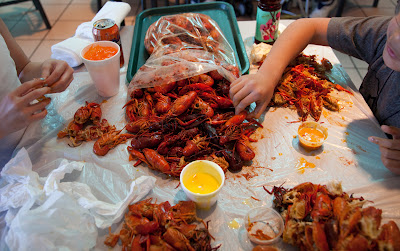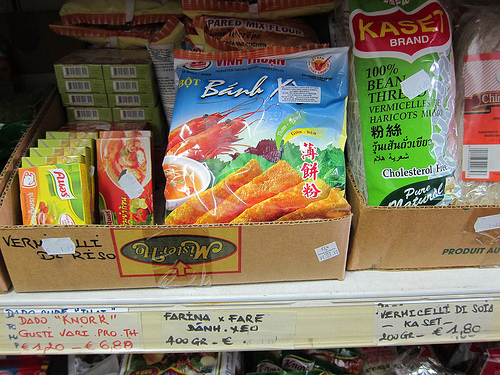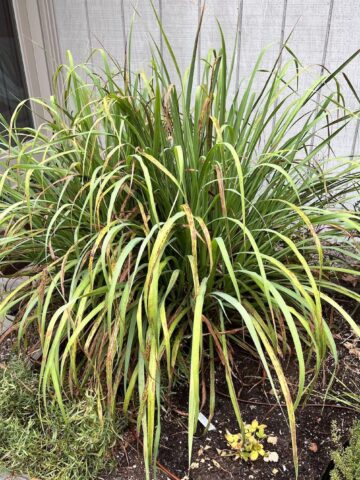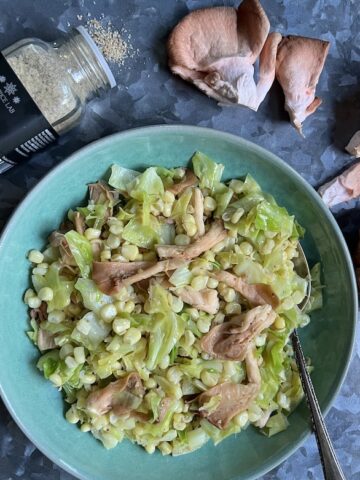
Immigration, geography and history are major catalysts for cultural change. With regard to Vietnamese foodways, you can trace the evolution of the cuisine to how populations have moved around. Case in point is the phenomenon known as Viet-Cajun, which stemmed from Viet-Americans who settled in the American South and fell in love with seafood boils. The result has been a plethora of Vietnamese crawfish restaurants – noisy, themed establishments (you’re invited to write on the walls) that serve super spicy boiled seafood with a classic Viet dipping sauce of salt, pepper and lime. Scenes such as the photo above taken by Penny De Los Santos, are pretty common at these Viet-Cajun restaurants.
The Southern Foodways Alliance (SFA) asked me to research and make a symposium presentation on Viet-Cajun eateries as it they’ve developed in California. There are many complexities to story, which is one about generational shifts as much as it is about fusion food.
If you want to know more, you can listen to my SFA presentation or read an essay on it in the newly released Cornbread Nation 6 anthology of Southern Food writing. The Cornbread Nation book club just kicked off with a discussion of the Viet-Cajun. Join that conversation or add your comments here on topics such as: Have you eaten at one of these places? What are your thoughts? Is Viet-Cajun here to stay?
Being a Foreign in Your Own ‘Hood
It’s interesting to note that while Thai people are familiar with Vietnamese food (they’re neighbors), Viet cuisine is a novelty in other parts of Asia. Manila-based Tracey Paska recently interviewed me for this magazine article on Vietnamese cuisine, tradition and in particular, street food:
Sans Rival Manalogue - Vietnam Palate It was for Rustan’s, a high-end gourmet supermarket that’s currently doing a campaign on Viet food. Tracey used to live in the US, where she ate at Viet restaurants in Falls Church, VA and Minneapolis. When asked about the popularity of Viet restaurants in the Philippines, she wrote:
My sense is that Vietnamese food has not yet reached the level of familiarity or popularity as other Southeast Asian cuisines (namely Thai or Singaporean), although there are several restaurants in and outside of Metro that serve very good Viet food. The most popular ones are chains such as Pho Hoa and Pho 24 (I believe both originated in Vietnam), while two highly regarded restaurants are Ba Noi in Makati City and Bawai in Tagaytay (just south of Manila). The owners of the latter two are both Filipina ladies married to Vietnamese gentlemen. Personally, I find that the menus in 3 of these (I have yet to visit Bawai) are somewhat limited compared to what my husband and I enjoyed in the States. For instance, Pho 24 offers only one kind of bun [round rice noodles], and it's listed on the menu as Grilled Pork Noodle Salad. As such, I feel there is still a long way to go before the full range of Vietnamese cuisine is familiar and appreciated.
Both Filipino and Vietnamese cooking rely on fish sauce so perhaps someday we’ll see a little blending of the two cuisines in the Philippines. The tropical Southeast Asian climates and resources are somewhat similar. If you’re familiar with Filipino and Viet fare, lend us your thoughts.
It’s in Your Soul
Amie Thao has been bicycling across Europe and Asia, dispatching her observations on food and people as she pedals along. She came across my radar when she wrote about reading an ebook version of Asian Tofu on her Kindle in a tent somewhere in the countryside! While she didn’t have access to a kitchen, the cookbook reminded her of how important tofu is to her, someone who on a journey far from home. Her was sweet and got to the heart of the matter.
Then Amie wrote about finding Vietnamese food and people in Italy. The photo below is from her post titled “People Who Look Like Meâ€:
There are 3,000 Vietnamese-Italians, Amie writes, and she happens upon a shop owned by a Viet couple in Bergamo located in northern Italy’s Lombardi region. She strikes up conversation and among the quotes from the Viet-Italian woman is: “Being Vietnamese is a feeling, it is a choice, no one can force it away from you. When I go outside my home, I act Italian, but inside my home, I follow my heart.â€
It is a universal truth. A person can leave their country but the soul of a country always remains with the person.


















Yun Ho says
Hi Andrea:
Loved your perspective about Exploring the Vietnamese Palate article. Street vendor foods are far more creative and tastier and it is amazing how they could come up with such delicacies in limited spaces. For those travelling to Ho Chi Minh City who want to try out street foods but are bit hesitant, they should try Quan An Ngon restaurant where they gathered various street foods in a western style restaurant environment.
Tracey@Tangled Noodle says
Thank you for sharing the sansRival article on your site! It was a pleasure (and very crave-inducing) to discuss Viet street food with you.
Perhaps someone more knowledgable about either cuisine may correct me, but one thing I've noticed on the difference between Viet and Filipino cookery is in their flavoring agents. Although some ingredients are common to both, such as ginger, lemongrass and galangal, it seems to me that Viet food makes more use of spices and fresh herbs, while Filipino food uses more fruits (tomatoes, saba/plantains, a variety of unripe fruits, etc).
As a Filipina, I find so much to love about Viet food, particularly in its flavorful grilled meats, noodle soups and desserts. Banh khoai mi (coconut cassava cake) always helped sate my craving for something sticky and sweet, like Filipino kakanin (rice-based delicacies).
With Manila only a 3-hour flight from Hanoi, my husband and I hope to visit Vietnam very soon!
BettyAnn @Mango_Queen says
What a great article about Vietnamese-Filipino cuisine. I love love this one. I am going to share this right away on the networks. Tracey @TangledNoodle is an exceptionally gifted writer in Manila,and has done a great job in this write-up for "Sans Rival", the magazine of Rustan's.
Thanks for all the insights, as well, Andrea. You both make me want to get on a plane and fly to Vietnam right now!
Gwyneth says
Interesting article! Yes we have experienced the Viet-Cajun trend here in San Francisco@ Crawfish. It is a lot of fun. We took a couple of friends who had never experienced eating like that before. They really felt like they had experienced a cultural first. I love your blog, keep it up!
leah says
On the question of Vietnamese cuisine in the Philippines, perhaps the Philippine-based author should explore the former Vietnamese refugee centers in Bataan. I am only guessing here, but it is quite possible that there was some cultural intermingling there. I will not be surprised if some of the Vietnamese decided to stay, perhaps intermarry with the locals, open restaurants, etc. Could be an interesting read.
Michelle says
I'm an American born Filipino married to a Vietnamese guy. When we first got together, I was very surprised to discover that there were so many things that were familiar to me -- fish sauce, sour soups, etc. For my husband, the fact that the rice cakes and halo-halo resembles the sweet banh che that he grew up with tends to be his favorite. When we were first getting to know each other (and each other's families), the similarity between the food cultures was a great comfort.
Much of what I cook tends to be a melody of what we're both familiar with. For example, the "sour fish soup" I make has elements of both Filipino sinigang na isda and Vietnamese canh chua ca. When we eat fried fish -- a childhood favorite for both of us -- we eat it with the nuoc cham (he's in charge of mixing it up) and a tomato/scallion salad that both of us remember from our childhoods.
Corrie says
"A person can leave their country but the soul of a country always remains with the person."...I totally agree and I think it even goes one step further. My parents immigrated to Australia from Holland and yet even though I was born in Australia I have a craving for the foods stuffs of the Netherlands eg, herring, salted licorice etc...
Victoria from Great Vietnam Holiday says
A great article, really nice to see different perspectives
pimsleur says
Your article about Vietnamese language is really interesting. Thanks for sharing your idea with us. I have intensive knowledge about Vietnamese language , culture and we are making a plan to teach Vietnamese language with the pimsleur method for our students so that they will have sufficient knowledge about their native Vietnamese language.
satiereal saffron extract calgary says
Although geographically and linguistically labeled as Southeast Asians, long periods of Chinese domination and influence have placed the Vietnamese culturally closer to East Asians, or more specifically their immediate northern neighbours, the Southern Chinese and other tribes within the South China. Thanks.
Sizlack says
Not.